

The Ontario Road Building Hall of Fame
Member Profiles
• Deep Foundations
• J.C. Rock Scholorships, Green Awards, College of Trades and more…



Building
Int




































































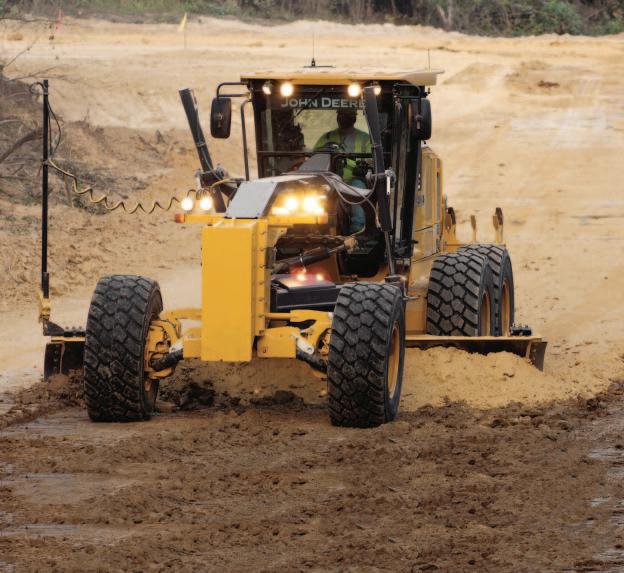


The Road
365 Brunel Road, Unit 1 Mississauga, ON L4Z 1Z5
Tel: (905) 507-1107
Fax: (905) 890-8122 www.orba.org
Publisher Robert Thompson Editor Ali Mintenko
Contributing Writer Matthew Bradford
Sales Executives
Gary Fustey, Walter Niekamp, Ashley Privé, Jack Smith, David Tetlock
Production Team Leader Adrienne N. Wilson
Graphic Design/Directory Specialist Krista Zimmermann
Published by:
5255 Yonge Street, Suite 1000 Toronto, Ontario M2N 6P4
Toll Free: (866) 216-0860 ext. 229 robertt@mediaedge.ca
531 Marion Street Winnipeg, MB Canada R2J 0J9 Toll Free: (866) 201-3096 Fax: (204) 480-4420 www.mediaedgepublishing.com
President Kevin Brown
Senior Vice-President Robert Thompson
Branch Manager Nancie Privé
Publication

Rob Bradford Executive Director
Thumbs Up to CFAAST and Cardus
Cardus and CFAAST – key developments in two of the high priority issues on the ORBA agenda. Both documents offer progressive insight and both are extremely important in their own contexts. Both stories are told in more factual detail in this issue of Road Builder, but this column provides opportunity for partisan comment.
Cardus first. This is the second report from the independent think-tank that casts serious doubt on whether the new College of Trades can possibly fulfil its mandate and the rationale for creating it in the first place. Conceived as a self-regulating body that will facilitate the objective of expanding compulsory certification of workers into more trades, the first Cardus report showed that its creators just kept charging forward even though there was no research-based evidence whatsoever to indicate that expansion of compulsory certification is sound public policy. “The fear is that the rapid movement towards compulsory certification by the College of Trades is being done in a research vacuum,” said Cardus.
Then came Cardus II in September – this time pulling no punches and calling the College of Trades an “impossible institution, the College of Trades has been designed to be an ineffective, biased and potentially costly waste of taxpayer’s money.” A huge new bureaucracy is being built
and it is flawed from so many perspectives that the only responsible course of action now is to start over again – this time by taking a research-based look at whether expansion of compulsory certification is even a good idea.
ORBA is only one of a growing number of construction organizations that have concluded that the College of Trades has to go. The institution itself is fraught with structural flaws, has serious conflict of interest issues and is prejudiced by both internal and external politics. Left unchecked the College raises concerns in the civil construction industry about disruption of practical union jurisdictional precedents, constriction of labour supply, increased construction costs and harmful interference with established and proven industry recruitment and training processes.
The Liberal government was returned to power in the October provincial election and based on pre-election platforms that unfortunately means full steam ahead in crafting the College of Trades. However, with the Cardus report now on the street, the construction industry will be pressing for a sober second-look at the College of Trades before it’s too late.
CFAAST on fairness
Second topic – CFAAST. This is the independent review of the ‘fairness, equity and transparency’ of the Ministry of Transportation’s claims and
ONE
INSISTS ON AN ENGINE THAT DOESN’T KNOW WHEN TO QUIT
Why choose an International® WorkStar® with a MaxxForce® 11 or 13 Big Bore engine? Because in your business, you need a truck that shows up for work day after day, year after year.
Thanks to a cylinder block made of compacted graphite iron, these engines are stronger and lighter than engines made from grey iron. And they’re good to go for 1.2 million miles.
WorkStar also features MaxxForce Advanced EGR, the industry’s only no-hassle solution for 2010 emissions. That’s no added equipment, training or maintenance—and no liquid urea.
Hard-working, long-lasting trucks and engines keep your business operating at its best. That’s what results when all of us—business owners, drivers, engineers—work together as ONE.


®

®
infractions processes done by the Ministry of Finance’s internal audit team, at the request of MTO. It comes at the same time as ORBA is discussing the administration of liquid damages with MTO and touches on many of the same issues.
The CFAAST team spoke to ORBA, individual contractors, other jurisdictions, legal experts, Ministry staff and others in preparing its report and the



If you’re going to build it to last, why not start with experience 100 years in the making?
www.aecon.com
result is an honest well-reasoned list of recommendations that, if acted upon, would go a long way in addressing issues of process that ORBA has been raising with the Ministry for many years.
The bottom line is that the CFAAST report sets out a number of areas where MTO ‘might consider’ changes to improve fairness and transparency in its claims and infractions processes.

BUILDING THINGS THAT MATTER
Roads
Bridges Aggregates
Asphalt
Lighting
Traffic Control
Signage
At Aecon, our road to success has been a century long. We know about seamless road and bridge construction, the importance of exceptional raw materials and proven performance value of ‘just the right’ asphalt hot mix.
Superhighways and super structures require superior expertise.
We know the road … we’ve been on it for 100 years.
And one really can’t talk about the claims and infractions processes without also looking at how they relate to MTO’s qualifications and dispute resolution processes.
The report emphasizes the need to shrink timelines in the claims resolution process and calls for more clarity and transparency in issuing infractions and other sanctions. The report suggests consideration of a binding, third-party decision process and talks about a number of innovative processes that are designed to deal with disputes before they become disputes. CFAAST also questions MTO’s use of the infamous ‘Exclusion Clause’ in its qualification documents which threatens reduced bidding privileges if a contractor makes use of their legal right to challenge the Ministry in court.
The only argument one might have with the CFAAST report is that it prefaces each of its recommendations with the qualifier that MTO ‘might consider’ the suggestion – much better that at the very least it read ‘should consider’ because some of the issues raised have been festering for far too long already.
It is a bold and progressive report and MTO is to be congratulated for taking this hard look at how it does business. The Ministry responds positively in the report with commitments to consider and respond to each recommendation. ORBA has requested that the recommendations be considered jointly.
The industry views the CFAAST report as a milestone document that offers the opportunity to take a comprehensive look at how the Ministry manages contractors and contractor performance and to implement some meaningful changes to improve the ‘fairness, equity and transparency’ of the relationship with the industry’s largest single customer.





Around Queen’s Park
Four Years of Minority Politics?

by Karen Renkema, ORBA Director of Government Relations
As the industry is contemplating the next four years (or less) of a minority government, it is important to reflect on what the last four years of a Liberal Majority government brought to those who build transportation infrastructure. Of course, the highlight for us is a direct result of the global economic conditions over the past four years: record infrastructure spending with the goal of stimulating our economy and most importantly, creating jobs.
And then there were the policy, regulatory and legislative pursuits of the McGuinty Government – the College of Trades; HST; the 10-year
infrastructure plan; the WSIB Funding Review; amendments to the CVOR Program; handheld device (cellphone) regulations; Bill 160 (moving OH&S Prevention function from the WSIB to the MOL); and the list goes on.
Finally, there were politically subtle, but very important storylines within the Ministry of Transportation, Provincial Highways Management Division. The CFAAST review; delay of contracts tendered because of exterior pressures; road and bridge budget announced vs. actual spend; liquidated damages; Windsor-Essex Parkway and 407 procured as AFP’s; safety in our workzones; funding pressures on the roads vs. transit question; and finally the bundling of MTO projects and future project delivery by Infrastructure Ontario. There were many more issues we worked on with MTO (for example, General Conditions Review), however I have listed only those that had political and government relations functions connected to the issue.
In review of the above lists I think most may agree that it has been a reasonably good four years for the industry, in respect to infrastructure spending. I’d suggest we are batting 500 when we focus on the policy issues we have dealt with over the past four years –both with MTO, as well as the many other ministries and agencies that ORBA deals with on a daily basis. Not a bad metric in baseball, but in reality for an industry that provides a product which increases economic productivity and competitiveness, as well as many well-paying jobs, we believe that
transportation infrastructure contractors, furthermore the contractor contingent of construction industry, must continue to be a stronger voice over the next four years.
On each of the above issues (and many more) ORBA was your voice at Queen’s Park. As we wade through four years, or less, of minority politics we plan on being an increasingly effective voice for you as a minority government presents us with complex and challenging dynamics. We have added another individual to our staff whose primary focus will be on legislative and regulatory priorities at Queen’s Park. As our focus expands at ORBA from just advocating for infrastructure investment (that advocacy remains a priority but will need to be increasingly complex and strategic), to increasing pressures on the regulatory front, the ORBA board recognized the need for more resources to adequately represent our industry’s concerns and needs both at the Provincial and Municipal levels of government.
Now back to the original question –four years of minority politics? At the time of drafting this article my crystal ball is still a bit foggy. The Cabinet has yet to be announced and the Speaker has yet to be elected. There are many possibilities for this “major-minority” as Premier McGuinty so effectively termed his newly elected government. As many political pundits have highlighted, the election of the Speaker from either opposition party, or from the governing party, will have a considerable impact on how politics will be played out in legislature over the coming years. Further, rumblings of a
“Judas” crossing the floor to join the Liberal team continues to haunt both the PC’s and NDP.
And what about a by-election? There are many MPPs that have given many years of their lives and careers to the legislature. It is quite possible that given a minority situation or another opposition situation for the PCs / NDP, that retirement could be attractive. Of course, a confidence vote could bring us back to the polls immediately after the 2012 budget, but will the opposition parties agree that the lethargic voters in Ontario are ready for another election that quickly? Time will tell – and we may have our answer sooner than later.
But for now we look forward to working with a Liberal Minority Government. ORBA has built many relationships over the past four years, and will continue to nurture those relationships with Ministers, MPPs and their staff. As an industry, we must recognize that there are tough choices ahead for this Government. First, the Government will be challenged to find issues of consensus by working with the other two parties. Even with a “majorminority” the Liberals will be more cautious on contentious issues (the ORBA issue of safety cameras comes to mind here). Even more important is the structural deficit situation we face in Ontario, specifically the strain that healthcare and education expenditures are placing on our provincial coffers. Through the 2011 Budget the Liberals signalled their concern, and intention to find savings in the provincial budget. Don Drummond, former Chief Economist for TD, was appointed to lead the “Commission on the Reform of Ontario’s Public Services.” Here is an excerpt of the commission’s role, directly from the Ministry of Finance’s website:
Commission to Assist McGuinty Government in Taking Action to Find Efficiencies, Improve Value …Building on reforms already underway, the commission is examining the way government delivers services to
people, including the following:
• Programs that are no longer serving their intended purpose and could be eliminated or redesigned;
• Areas of overlap and duplication that could be eliminated to save taxpayer dollars; and
• Areas of value in the public sector that could provide a greater return on the investment made by taxpayers.
The commission will report to the Minister of Finance in time to inform the development of the 2012 Budget. It will not make recommendations that would increase

taxes or lead to the privatization of health care or education.
Most certainly the report from this commission will affect the 2012 Provincial Budget, and provincial budgets following. More importantly, to ORBA members, Drummond’s recommendations will affect the spending on different categories of infrastructure, delivery and procurement of infra-
structure, and most importantly the funding of future infrastructure.
Because of the nature of ORBA members’ businesses and daily work, our industry tends to be project focused. The macro vision is never lost, but the long-term issues sometimes play second fiddle to the immediate pressing issues. At ORBA it is our job to ensure that long-term thinking and a

strategic approach is given to the issues most important to our members.
The “macro” issue of long-term infrastructure investment, and furthermore, the increasingly politically charged climate and “nimbyism” related to building infrastructure must be our top priority over the next four years at Queen’s Park.
Advocating for transportation infrastructure investment is priority number one for ORBA, because we recognize this is the most important issue for our membership. As mentioned before, advocacy on this issue requires a great amount of sound strategy, and also involvement in issues that historically ORBA has not been involved in – for example, road tolling.
At the recent ORBA membership meetings I outlined both challenges and opportunities as they relate to advocacy on infrastructure investment. From the 10-year Infrastructure Plan, to the funding and financing of infrastructure through alternative sources, to federal gas tax revenue utilized on municipal buildings instead of roads, these issues and many more present us with opportunities to expose additional funds for transportation infrastructure. They also present a challenge to an industry, which on a daily basis confronts a regulatory environment that impacts both business processes and an increased cost of delivering infrastructure projects.
Our challenge at ORBA is to bring together all of these ideas and issues, and formulate a strategy that appeals to a government in a minority situation, and also opposition parties that have all been elected with significant and specific regional representation. We will continue to carry the message of the jobs you have created, the capacity that exists in the industry and the requirement for additional transportation infrastructure in order to move Ontario forward, and increase economic productivity and competiveness well into the future…well beyond another four years.



Considered the company’s most challenging project to date, its installation of a 30-metre access shaft beside the St. Clair river in Sarnia won it the Outstanding Project of the Year award from the Deep Foundations Institute.
Deep Foundations Celebrates 40 Years of Innovation and Market Leadership
By Matt Bradford
Deep Foundations has a lot to celebrate on its 40th anniversary year. With over 3,000 projects under its belt, and numerous accolades and ‘industry firsts’ on its mantle, the long-standing foundation contractor has carved a respectable place for itself in the industry, and placed the company on solid footing for years to come.
Established in 1971 by Bill Lardner and David Miller, Deep Foundations has evolved from a modestly staffed one-drill operation to a large-scale contractor specializing in below ground work for the construction trades. Today, Deep Foundations is home to over 200 employees, a sizeable inventory of pile drivers, vibratory hammers, and one of
North America’s largest fleet of hydraulic drills. As such, Deep Foundations is equipped to provide job sites with all manner of foundation services including driven piles, caisson piles, secant piles, CFA piles, micropiles, helical piles, soldier piles, and sheet piles.
“Our strength is our diversity,” says president Bill Starke. “We install all types of piles, whereas our competition generally tends to specialize in one type of pile or another. We try to be very diversified.”
A graduate from the University of Western Ontario Masters engineering program, as well as a former CFL football
player drafted by the Edmonton Eskimos, Starke has been an integral part of Deep Foundations’ operations for over 25 years. His leadership is bolstered by the support of the company’s other principals — Peter McDonald, Mauro Scanga, and Michael Cianchetti – all of whom help Starke oversee Deep Foundations’ large fleet of equipment and the 150 field crew, 30 office employees, and 30 fabrication shop workers that comprise his staff.
“One of the biggest things that sets us apart is our great people,” insists Starke. “We provide continuous training sessions for our supervisors, operators and labourers, and really that’s a great part of our success — our talented employees.”
Truly, Deep Foundations’ people are its lifeblood, and it’s this access to talent that has spurred the development of numerous in-house inventions and innovations. For example, Deep Foundations was the first contractor in Toronto to use secant piles, a specific type of excavation shoring for wet ground conditions.
“Secant piles are typically drilled at one-metre diameter. Each pile overlaps with the piles on each side, forming a continuous watertight wall,” explains Starke, adding, “We brought that technology to Toronto in 1984, and now it’s very common. It’s used throughout Canada.”
Deep Foundations was also the first contractor to bring hydraulic caisson drills to the Canadian construction scene in the early 2000s. Other innovations include the introduction of soil anchor tie-backs, used to support excavation shoring walls, and continuous flight auger piles used primarily for building foundations.
One of Deep Foundations’ most high-profile inventions is its Spotter device for pile drivers, an additional piece of equipment with a microcontroller which, when connected to the frame of a crane, provides torsional support to the bottom of the lead.
“When you’re doing battered piles, there’s always a danger that torsional load is going to be put into the lattice boom, which is forbidden,” explains Starke. “This device ensures that no torsion travels up the lead and goes through the lattice boom. It ensures that it comes down through the lead, into the Spotter and into the frame of the crane, which can take torsion.”
According to Starke, the Spotter was created to prevent further damage to pile driving equipment and increase job site safety. “Like all pile drivers, we’ve had our share of close calls and damaged booms from doing battered piles, so this invention was out of necessity; there was nothing available that dealt with taking the torsion out of the lattice booms. When you damage a boom, if you’re lucky it stays standing and you fix the boom. But if it’s a little

worse, then you can have an accident. We didn’t want that risk anymore.”
Deep Foundations has since sold the international patent for the Spotter to an equipment manufacturer, and anticipates the product to be ready for retail shortly.
No doubt, Starke and his team have been busy over the past 40 years. The company’s portfolio includes the excavation pit for the CN Tower in the early ’70s, as well as



Deep Foundations’ new facilities, built in 2009, include equipment repair shop and 9 acres of outdoor storage.

In 2010, Deep Foundations installed a 15-metre deep secant pile wall at George Brown College’s Waterfront Campus to facilitate a dry excavation.
Deep Foundations’ track record has also won it acclaim amongst industry peers. In 1998, the company was awarded the Outstanding Project of the Year award from the Deep Foundations Institute, a worldwide association of foundation professionals. The award was given in recognition for its success with the St. Clair River Tunnel Project, a job wherein the company was tasked with installing a 30-metre rescue shaft to retrieve a malfunctioning boring machine that was being used to put a new railroad tunnel underneath the river.
“It was quite a challenging job because of the ground conditions. The soil there was a very soft clay that, when excavated, would squeeze back into the excavation almost as fast as you could dig it out. It was very difficult. Throughout the years in that same area there had been many times when other contractors tried to put in shafts for various tunnels, and every one failed. This was the first successful access shaft to a tunnel in that Sarnia clay,” recalls Starke.
Other feathers in Deep Foundations’ cap include the International Association of Foundation Drilling Award, given to the company by the Texas-based association for having the lowest number of accidents per man hour in all of North America. Closer to home, Deep Foundations also received ORBA’s Road Builders Safety Award in 2002, 2005, 2007, and 2008.
Emphasizing its commitment to maintaining an accident free operation, Starke says: “We’re very proud of our safety rating. In the low bid environment, that’s what gives us an edge: our good reputation and our excellent safety rating.”
foundation work on the Princess Margaret Hospital, the Toronto Pearson Airport, Skydome, the Department of National Defence, and numerous landmarks across Toronto. Currently, Deep Foundations is being kept occupied with infrastructure projects on four out of the five contracts for the Toronto-York Spading Subway Extensions, including the Steeles Avenue station with Walsh Construction, Sheppard with Aecon Construction, Finch with Bondfield Construction, and the Vaughn Corporate Center with Carillion Construction.



With its ruby anniversary in its rear view mirror, Deep Foundations is primed and ready for more. Looking forward, Starke hopes to continue bringing new ideas to the market, and create an even greater presence in the industry over the next 40 years, noting, “Innovation is always important to us. We’re always looking at new technologies.”
Deep Foundations is located at 145 Ram Forest Road in Gormley, Ontario, and can be contacted by phone at 1-877-642-7055, or through its website at www.deep.ca.


Tractor Rentals
• Save Capital
• Eliminate Repairs
• No Long Term Commitment
• No Depreciation or Replacement
• Wide Variety of Late Models from 55 HP – 200 HP
• Attachments Include; Loaders, Wagons, Mowers etc.




• 22' Reach with 50" HD Flail Head Capable of Handling up to 5" Brush — 50" and 60" Rotary Heads also Available
• 75" Side and Rear Flail Mowers Available
• Ideal for Mowing and Brushing along Roads, Walking Trails, Right of Ways etc.
• Weekly and Monthly Rentals










LET’S WORK.
LET’S WORK.
For pavers that will keep your business rolling, look to Strongco Equipment for quality road-tested Volvo machines with maximum tractive effort. Our pavers will keep your asphalt product workable while paving the way for more profits.
For pavers that will keep your business rolling, look to Strongco Equipment for quality road-tested Volvo machines with maximum tractive effort. Our pavers will keep your asphalt product workable while paving the way for more profits.
Let’s work together. Visit Strongco Equipment today to get started and see for yourself how Volvo equipment is built for the road.
Let’s work together. Visit Strongco Equipment today to get started and see for yourself how Volvo equipment is built for the road.
Calgary 403-216-1010
Grande
Red
506-857-8425
Newfoundland 709-747-4026
506-857-8425
Grimsby 905-643-4255 Kitchener 519-744-3518
Grimsby 905-643-4255
Kitchener 519-744-3518
London (Lambeth) 519-652-3234 Mississauga 905-670-5100
London (Lambeth) 519-652-3234
Mississauga 905-670-5100
Ottawa (Stittsville) 613-836-6633
Ottawa (Stittsville) 613-836-6633
Sudbury (Lively) 705-692-5801
Baie-Comeau 418-296-3091
Boucherville 450-449-4666
Sudbury (Lively) 705-692-5801 Thunder Bay 807-475-3052 Baie-Comeau 418-296-3091 Boucherville 450-449-4666 Chicoutimi 418-690-1724 Laval 450-686-8911 Ste-Foy 418-653-2801 Val-d’Or 819-824-2791
Thunder Bay 807-475-3052
Chicoutimi 418-690-1724
Laval 450-686-8911 Ste-Foy 418-653-2801
Val-d’Or 819-824-2791

‘An
Construction Coalition Calls for Overhaul
or Abolition of
Impossible Institution’
There is growing opposition in parts of the construction industry to the College of Trades, a new bureaucracy being built to regulate and manage the province’s skilled trades (all industries), with specific focus on compulsory certification of trades and determination of apprenticeship ratios.
When Legislation creating the College of Trades was passed in 2009, some of the construction industry had concerns but decided to take a cooperative approach to developing the College in the hopes that concerns could be addressed through the process. Two years later a damning report has been released by Cardus, a well-known Hamilton-based public policy think-tank, and some construction employers have
now determined that the current vision for the College is too broken to fix. They are calling for “the abolition or overhaul” of it by the government.
“The provincial government must act fast to either overhaul or abolish the College of Trades and engage in a collaborative, open and transparent process with all stakeholders…,” said Sean Reid, spokesperson for a coalition of construction associations from the Progressive Contractors Association of Canada in a September 20 news release.
The construction coalition for which Reid was speaking includes the Ontario Road Builders’ Association (ORBA), Ontario Sewer and Watermain Construc-
tion Association, RESCON, Ontario General Contractors Association, Ontario Electrical League, Heavy Construction Association of Toronto and Merit Ontario. Not all sectors of the industry are opposed to the College however. Trade associations that already have compulsory certification support it. Generally, employers of non-compulsory certified tradespeople and/or non-union workers are those that see significant negative impact on their businesses and labour supply if the College proceeds on its current path. Most of the provincial building trade unions are solidly and actively promoting the College.
College of Trades
In 2007, the government appointed Tim
Armstrong to make recommendations to the Minister of Training, Colleges and Universities about if and how to expand compulsory certification to individual voluntary trades. Armstrong is a former deputy minister of labour and former chair of the Ontario Labour Relations Board and his April 2008 report created the vision for College of Trades.
Though the report was little more than that – a vision and recommendations
admittedly lacking in research-based support – the government reacted with alacrity rarely seen in such matters of public policy development. Within four months it announced its intention to establish a College of Trades. Kevin Whitaker was appointed as an “implementation advisor” and he delivered his report to the government in May 2009.
The Ontario College of Trades and Apprenticeship Act came into force in 2009. Among

other provisions, the law mandates the formation of a Review Panel that will consider applications that seek to change certification in many trades from voluntary to compulsory.
The Cardus Report


The Cardus report, titled: College of Trades: An Impossible Institution was released in September and concludes that there is no evidence to show that it can solve Ontario’s problems with its trade and apprenticeship system. To the contrary, Cardus finds four key “structural flaws” with the design of the College:
1) The College was founded on the premise that a self-regulating body would solve the very real issues in Ontario’s skilled trades sector with no research-based evidence to support this claim. “From the start, the entire process for appointing members to the various governance bodies at the College of Trades has been shrouded in secrecy with little or no public consultation with the skilled tradespeople it will be regulating,” says the construction coalition in commenting on the Cardus report.
2) The College is poised to become a massive bureaucracy to support 157 trades in Ontario with a significant financial cost that will ultimately be funded by Ontario taxpayers, businesses and skilled tradespeople.
3) The College’s governance structure is dominated by representatives of unionized, compulsory certified trades in Ontario, to the detriment of uncertified trades that form the majority of skilled tradespeople in the province (74 per cent).
4) The College’s role is redundant as skilled tradespeople in Ontario are already well-regulated by other regulatory bodies.
In their concerted lobby to first establish and now influence the College of Trades, construction unions have promoted worker safety as one of the primary reasons for pursuing compul-
sory certification of trades. However, Cardus clearly shows that absolutely no research-based correlation has been established between worker safety and compulsory certification.
Costs to operate the College are a predominant theme in the Cardus report. No costing information has been shared with the public, even though the blueprint indicates a large, new bureaucracy will be needed to operate it. Nor is there any information about who will pay and how much will fall to taxpayers. In theory the College is to be self-funded by fees
Though the report was little more than that – a vision and recommendations admittedly lacking in researchbased support – the government reacted with alacrity rarely seen in such matters of public policy development.
from its members – tradespeople – but beyond that nothing is known about how fees will be set or what they will be. For unionized employers, however, it’s a safe bet that College fees will be an issue in the next rounds of collective bargaining.
Concerns about the self-funding nature of the College are also structurally intertwined with its mandate to hear and rule on applications for compulsory certification. The architects designed the College to grow. It possesses the legal tools to grow both its membership and its financial base through the expansion of compulsory certification and increasing of fees. There is an inherent conflict
in the College’s abilities to increase its funding by promoting and granting compulsory certification to more trades and its responsibility to review certification applications impartially.
Lack of transparency in the development of the College of Trades is another theme running through the Cardus report. Key appointments have been made in secret with no public explanation. The Col-
lege has not been forthcoming with any information about its activities and cost projections. Members of the Transitional Appointments Council/Transitional Board of Directors, the body empowered to make appointment to the College’s various boards and councils, have been muzzled since the beginning of the process and all information they receive in the course of fulfilling their roles is considered classified.


There are significant unanswered questions and concerns about how the primary issues of compulsory certification and apprenticeship ratios are to be decided. Criteria for the decision-making on compulsory certification and ratios have not yet been made public, although consultations on this issue took place in November 2010. Membership on panels that will decide matters of compulsory certification and ratios and the basis on which they are to be appointed remains unavailable to the public. The College’s
governance structure is known only to College insiders and secrecy is protected by the Legislation.
Industry Reacts
“This province is on the verge of a fragile economic recovery with the skilled trades playing a critical role in supporting our economy,” said Jason Ottey, director of research and policy for RESCON, and spokesperson for the coalition now calling for the end of the College of Trades as it looks today. “The last thing Ontario’s
Road Maintenance Division
WITH HIGH PERFORMANCE PRODUCTS.
employers and skilled tradespeople need is an ineffective, biased and potentially costly College of Trades that will do nothing to help us address the critical issues facing our sector...”
“The sheer size and complexity cast serious doubt on the ability of the College of Trades to achieve its mandate and the administrative support required to make this governance structure function effectively.” said Clive Thurston, president of the Ontario General Contractors Association in reaction to the Cardus report. “(It) will require large financial resources to be paid for by taxpayers, employers







Susan McGovern, assistant executive director of the Ontario Sewer and Watermain Construction Association challenged the rationale for creating the College in the first place: “The College of Trades was established to address the challenges facing the skilled trades in Ontario, yet there is no evidence-based research demonstrating that the College will be able to address these issues.”
In the road building sector, ORBA executive director Rob Bradford said the College of Trades as it is being implemented raises serious concerns about future labour supply, costs and disruption of traditional union jurisdictional understandings for road building contractors.
CASTONGUAY
“Our unionized members and their unions have established long-standing understandings about how jurisdictional matters play out in the field and it appears to us that the College will have the power in granting compulsory certification to also describe jurisdiction of compulsory trades. This has traditionally been a function of the Ontario Labour Relations Board and that is where the responsibility for union jurisdiction in Ontario should remain.”
Dyno Nobel





















The Ontario Road Building Hall of Fame
The Ontario Road Building Hall of Fame was created by ORBA in 2006 to recognize and honour the pre-eminent leaders in the road building industry – the men and women who stand out from their peers for their dedication, their leadership and their achievements. The Hall of Fame recognizes a person who has committed many years of service to the Association and who, by their efforts, has contributed to the overall strength, growth and/or improvement of the road building industry, their employees, their businesses and their communities.
Hall of Fame candidates are nominated yearly by ORBA members, Past Presidents or anyone who has a relationship to the industry. There is a voting procedure which requires candidates to receive a specific percentage of the votes cast in order to be inducted. Voting is done by the ORBA Board of Directors and Past Presidents.
There are currently 13 members of the Ontario Road Building Hall of Fame. Following is a brief introduction to each with their official portraits and the year of their induction to the Hall

of Fame. These very detailed pencil portraits are the work of Sarah Kelly, an Oakville photographer and artist.
R.J. Merlo (2006)
R.J. Merlo (deceased) was President of Sterling Construction in the 1950s and served as ORBA President in 1957. Mr. Merlo also served the Association as a volunteer secretary who handled a lot of the ORBA administration for a number of years when staffing was low and finances were tight. A search of the ORBA archives shows that Mr. Merlo was an active promoter of the industry’s interests in areas ranging from labour relations and specifications to promoting infrastructure development.
Martin MacDonald (2006)
Martin MacDonald (deceased) was the Executive Director of ORBA for 20 years from the 1960s, through the ’70s and into the early ’80s. He was respected within the industry for his knowledge about the road building industry and his ability to bring about changes for contractors. He was a no-nonsense association manager who upheld ORBA traditions and promoted road builders’ interests for over two decades.


R.J. Merlo (2006)
Martin MacDonald (2006)




King Beamish (2006)
King Beamish (deceased 2010) was a dominant figure in the Ontario road building industry for over 60 years. A trained accountant, he joined A.E. Jupp in 1917. He was assigned to the Alaska Highway project for two years and shared a one-room building at the construction camp with his wife Dorothy when minus 50 degree temperatures were common.
When King Beamish returned to Toronto he started his own company in 1946. With his first truck he took his first job doing winter maintenance on Highway 2. The job required literally throwing salt off the back of the truck by hand.
In the 60 years that K.J. Beamish Construction has been operating in Ontario, it has grown to nine asphalt plants, sand and gravel holdings and a few quarries. While paving and construction remains the focus, the company has diversified into hydro seeding, mulching and waste management.
King Beamish is a founding member of the Canadian Federation of Independent Business and an Honourary Life Member of the Ontario Hot Mix Producers Association.
Marcel labelle (2006)
Marcel Labelle is a true road building pioneer. His company celebrated its 50th anniversary in 2005 and in over half a century it has graded and built countless highways in Northern Ontario. It has built winter roads to move wood and equipment to the pulp mills and operated aggregate crushing operations to serve the mining industry. It has strategic aggregate operations across the North and is a major employer in Northern Ontario.
Marcel Labelle is the founder and President of M.J. Labelle Construction Ltd., headquartered in Cochrane, Ontario. Stories of his adventures as a Northern contractor abound, beginning with a trip to Newfoundland in the 1950s to buy his first crushing
plant and then stomping the streets of Toronto to find bonding for a contract he already had.
There were winter-long treks with bulldozers and dog sleds across the permafrost to Hudson’s Bay and there were many winters in the bush camps that Marcel remembers with particular fondness. His employees in the 1950s were among the first in Northern Ontario to be offered company health benefits and pension plans.
leo McArthur (2006)
Leo McArthur was the President of ORBA in 1990 and served many years as the Ontario Vice-Chair of the Canadian Construction Association. He has served as a Board member and is a strong supporter of many related industry associations, and consistently makes available to ORBA a wealth of volunteer support from his employees. His service to the industry in representing ORBA members both provincially and nationally is unmatched.
Leo McArthur is president of The Miller Group, a diverse operation with companies specializing in road building and heavy civil construction across Canada and internationally. Miller companies are involved in every area of road and highway construction and always at the forefront of new technologies such as cold in-place recycling and warm mix technology.
In the 1970s Leo and his partner John Carrick started McAsphalt Industries to supply liquid asphalt cement and emulsions. They purchased Miller Paving in 1976 and since then have transformed it into a vertically integrated construction conglomerate offering material supplies, construction services and pavement maintenance, with operations across Eastern Canada and southeastern USA. The company employs over 2,000 people.
Leo has also demonstrated commitment to his community through charitable work with hospital boards,
Leo McArthur (2006)
King Beamish (2006)
Marcel Labelle (2006)
local police, sports teams and others. In 2002 he received the Queen’s Jubilee Medal in recognition of significant contribution to Canada, community and fellow Canadians.
les Cruickshank (2007)
Les Cruickshank was ORBA President in 1992 and served the Association in many capacities between 1972 and 1995. He was also President of the Construction Safety Association in 1982. Les is also well known as a vocal spokesman for the road building industry. The pressure he brought to bear on politicians to complete Highway 416 to Ottawa became so insistent they finally had to build the highway.
Not only recognized as a leader within the industry, Les Cruickshank has also left an indelible mark on his community. He is past president of Morrisburg Chamber of Commerce and a member of the Lions Club for over 50 years. He sits on his Church and Hospital Boards and is a past member of the St. Lawrence Parks Commission. The company is a huge supporter of local minor sports and community fundraising projects. Cruickshank construction built and donated to the village of Morrisburg an outdoor amphitheatre for the advancement of arts and sports.
Les bought his first grader in the early 1950s to work on the St. Lawrence Seaway and babied it back to Morrisburg on the highway at 22 miles per hour. On the way he stopped for lunch and graded the parking lot for his meal. The next year he bought a bulldozer and Cruickshank Construction was on the way.
He got his first real job with McNamara Construction in 1945, the day the War ended. In 1946 he went to work for Ontario Hydro for eight years. Over the past 50 years he built his company from a one-man operation to an employer of over 300 people. Les retired from Cruickshank Construction Ltd. in 1999, but continues to be actively involved in its management and operations.
Donald E. McQuigge
Donald McQuigge (deceased) was the President of ORBA for three years, beginning in 1953. He was a lawyer by profession but a road builder at heart. He was inducted to the Hall of Fame for his leadership during a period of turmoil in the industry and for the many significant changes that came about as a result of his leadership.
The co-founder of Peacock & McQuigge, Donald McQuigge grew his company to be one of the major road builders of the day. Its reputation for quality and expertise was made partially on its record working on the Alaska Highway project.
In the mid 1950s, McQuigge oversaw sweeping changes at ORBA that were greatly needed at a time when the Association’s influence was waning. He incorporated ORBA in 1954, grew the staff to five persons and accomplished a five-year, 14-point reorganization plan in just three years. Working committees were put in place, a labour relations service was established and connections at Queen’s Park were revived. By 1956, the Minister of Transportation would say that not one major policy decision had been taken without first consulting with the Association.
In the early 1950s, there were concerns about the lack of public tender openings, bid rigging and lack of transparency in the whole system. One of McQuigge’s first jobs in 1954 was to deliver an extensive brief to the Select Committee of the Ontario Legislature appointed to look at Department of Highways tendering practices. By 1956 ORBA had achieved a system of public tender openings and many other of the Association’s recommendations were also adopted over the coming years.
Perhaps the most significant change that came about as a result of McQuigge’s efforts was prequalification of DHO contractors. First recommended by ORBA in 1954, McQuigge took on the initiative as a



personal challenge and didn’t stop pushing until DHO opened its first prequalified tender in 1957. Some of the other important changes in the industry that were brought about directly by his personal commitment and persistence include: fair wage policies for non-union contractors; municipalities bonding; adoption by the Department of Highways of ORBA’s equipment rental rates and; the uniting of Ontario road builders
Les Cruickshank (2007)
Donald E. McQuigge




to combat fierce competition from American contractors for work on the St. Lawrence Seaway.
Roy Steed and Denis Evans
Roy Steed and Denis Evans were inducted to the Hall of Fame as a joint nomination. The two were inseparable in building one of the most respected and successful road building companies in Ontario – Steed & Evans Limited.
Roy Steed and Denis Evans graduated a year apart in civil engineering at the University of Toronto. Both took their first jobs at A.E. Rule Ltd., general contractors. Denis left after a year to work for Manix & McNamara on the new Toronto subway tunnels. In 1953 the partnership was born with the incorporation of Steed & Evans Limited.
They started as bridge builders but by the early 1960s had acquired Drope Construction Ltd. and Moyer Sand Limited to provide diversification. In the mid-1960s the company expanded to Nova Scotia and purchased several local companies. The bridge builders were now into road construction, aggregates, hot mix asphalt production and residential subdivision work. In 1967 Steed & Evans got into the winter maintenance business with their first Toronto Sand Camp contract and they still perform that contract to this day.
In 1970 the Kitchener construction division was created with the purchase of Blacktop Construction Limited. Nelson Aggregates was created in the 1980s in partnership with Standard Industries. Cambridge Asphalt Supply was formed in partnership with E & E Seegmiller also in the late 1980s and a few years later Kitchener Asphalt Limited was formed.
Their business success is a matter of record. But as Denis Evans and Roy Steed became successful road builders, they were also creating a legacy of personal accomplishment
and breaking new ground in the area of the employer-employee relationship. Unique to the company and well ahead of its time was a fully vested company pension plan for all salaried staff in the early 1970s. A profit sharing plan was implemented a few years later. In the early 1980s a stock option plan was established for senior managers. Today the company is owned and managed by a thirdgeneration management team, while Roy and Denis maintain seats on the Nelson Aggregates Board and manage their own affairs under Steed and Evans Holdings.
Roy Steed was President of ORBA in 1961 at the age of 37 which might well qualify him as the youngest president to ever serve. Denis Evans took his turn at the ORBA reins in 1984. Their commitment to ORBA and other industry associations has always been well beyond what one would expect from a company of their size. Over the years both Roy and Denis insisted that their company would become involved and show leadership through their participation. Steed & Evans employees have lent their time and expertise as Presidents or Chairmen of many associations. Roy Steed also served as President of the Nova Scotia Road Builders Association, and in 1981 he was the President of the Construction Safety Association of Ontario in 1968.
Charles (Chuck) lawrence
Chuck Lawrence was President of Huron Construction from 1982 until his retirement in 1996, and served as President of ORBA in 1968. He was actively involved in the very successful nationwide effort by TRIP Canada in the mid 1980s to document the deteriorating condition of the Canada’s roads and bridges.
Chuck is respected for his professionalism in establishing relationships with owners, particularly the Ministry of Transportation but also the local municipalities that were important to Huron’s business. He started his
Roy Steed
Denis Evans
Charles (Chuck) Lawrence
working life as a chartered accountant and he articled with a Chatham firm in 1958. In 1962 he went to work for Great Lakes Broadcasting System which had radio stations in Chatham, Kitchener and Orillia. It was the accounting background that took him to Huron Construction in 1967 and the beginning of his road building career.
Chuck Lawrence’s service to the industry is a matter of record. His work in the community includes serving as treasurer to the Chatham-Kent YMCA Board of Directors and as Chair of the General Hospital Society of Chatham. But his election to the Road Building Hall of Fame speaks as much to his reputation as to his record of service. His industry colleagues know Chuck as a gentleman who exemplifies the qualities of integrity, fairness and respect.
Russel Cox
Russel Cox was born in 1925 and raised in Wellington County. After graduating from high school he joined the Royal Canadian Engineers and remained until WWII was over. In 1946 at the age of 20, he began his construction career by collaborating with a partner to purchase a used gravel crusher. Eager to get started in the gravel business, they set up operations in Hillsburgh, Ontario.
After a brief partnership Russel founded Cox Construction Limited. Before the end of the first year, Cox Construction was awarded its first Department of Highways gravel contract on Highway 24 just outside of Guelph. The next few years were spent working in Northern Ontario. In 1953, Russel moved to Guelph and purchased a hot mix plant. Cox Construction became the first contractor in Ontario to use innovative, electronic grade and slope control systems on their asphalt pavers. He continued to build his company by adding motor scrapers and articulated haul units to support his existing operations. In the late 1950s a dirt business was born,
hauling earth of all types and grading. Stripping and quarry work has become a significant part of business.
Russel Cox, the man who created one of the province’s oldest and respected road building companies is a modest, hard-working and dedicated contractor. He is a forward-thinking man who is proud to have provided a rewarding, stable work environment to many employees over the years. His life and his career are a testament to determination, improvement of the road building industry and success in building his own company.
William (Bill) Doherty
Bill Doherty was President of ORBA in 1969 and stands out amongst his peers for his commitment to the Association and the industry over many years. In a road building career that started in the late 1940s, he has distinguished himself as a leader in the industry, within the companies he has worked for and in his community.
Bill was born in 1927 in Schomberg. He grew up with his brother Douglas farming, hunting and fishing and assisting with hard work that was a normal part of everyday life. He earned a degree in civil engineering from the University of Toronto and his P.Eng designation shortly thereafter.
Bill started his career with K.J. Beamish Construction in the late 1940s where one of his first jobs was to light the oil lanterns for night work. He eventually became General Manager at Beamish and in the late 1970s he purchased MSO Construction Ltd. from Beamish. Cornell Construction from Brantford was purchased in the mid-1980s, followed by J.A. Robbins Construction, later to become Paveseal Ltd. with its fleet of Patchmasters.
Bill Doherty is respected by his colleagues in the road building business for being a tough, fair and highly ethical competitor. In retirement, Bill has continued his work in the community.



He is very involved in the operation of the Richmond Hill Community Food Bank and is a strong supporter of the York Region Police Association. Bill has received numerous awards over the years for his work with community organizations.
Russel Cox
William (Bill) Doherty



William (Bill) Graham
Over the past 50 years Bill Graham has built one of Ontario’s largest independently owned road building companies. Born in Goderich in 1937, Bill grew up in Brampton. He got his introduction to construction in high school, working with his father Douglas. But his love of football led him down a different path at the beginning. It was in 1959, while playing for the Toronto Argonauts, that Bill founded Graham Bros. Construction with his brother Don.
The business started with an excavator digging basements for Bramalea and
Peel Village Developments in Brampton. Today the company employs about 400 people and is a major player in the road building and civil construction sector. The company is also one of Ontario’s leading bridge builders. A testament to the company he has built, Graham Bros. has over 20 employees who have been with the company more than 25 years. A few of them are approaching 50 years.
Well known for his passionate, tough approach to business, Bill is also known by his friends and competitors for being a fair and extremely knowledgeable contractor. He has been called an ‘icon’ in road building. In 1995 he was named “Business Man of the Year” by the Brampton Board of Trade. He served as an ORBA director for many years and has been a strong supporter of our industry associations. Through his personal business and political networks he has been a vocal advocate for the road building industry.
These days, Bill splits his passion between construction and horse racing and he owns about 50 thoroughbreds, with farms in Canada and the U.S. He has been a director of the Ontario Jockey Club for over 15 years. A community leader as well, Bill has always contributed generously to local charities, and especially the Brampton Civic Hospital,
Bruce S. Evans
Bruce Evans was born in Toronto but moved to Muskoka at an early age where his family wanted only to survive through the Great Depression. When he graduated from the University of Toronto, he and his brothers Gordon and Bob teamed up to supply sod, landscaping and general contracting. They won federal government contracts for roadwork and winter maintenance across Canada and theirs was one of the first companies to be awarded a winter maintenance contract from the City of Toronto.
Bruce purchased Fowler Construction
in 1971. He continued in the winter maintenance business, but expanded into landscaping and golf courses and Fowler got its first big break at Montreal’s Expo ’67. A number of other notable landscape projects following including Ontario Place, Canada’s Wonderland and over 100 top ranked golf courses across Canada. He led Fowler on a path of continuous expansion. And today the company has over 5,000 acres of aggregate resources at 32 locations. Over 400 employees at peak keep four asphalt plants and six portable crushing plants busy. Many of those employees have been with the company for more than 40 years and three have been loyal to Fowler for over 50 years.
Bruce Evans embraced the benefits of ORBA early as a road builder and became President in 1982. During his tenure as an ORBA Director he was a leader in promoting the industry’s interests at a time when the economy was in the dumper and interest rates were floating around 21 per cent.
Other than Fowler Construction, Bruce has launched many businesses which have had a positive impact on Muskoka, In the early 1990s he was one of the largest employers in the area with about 980 workers. He purchased Grandview Farm and turned it into an upscale 180-room resort with timeshare condominiums and two golf courses. His company, Forrec, designed and constructed facades for theme parks such as Disney and MGM and numerous Las Vegas casinos. His company Evanco Developments is today the largest land developer in the Muskoka – Parry Sound area.
Bruce is also respected as a community leader and is a patron of local hospitals and charities. One of his favourites is the Muskoka Children’s Foundation, which helps children who have no place else to turn. He is known to his colleagues in the construction industry for unwavering ethics, for his fairness and for his absolute integrity.
William (Bill) Graham
Bruce S. Evans


Dufferin Concrete Wins First ORBA ‘Green” Award
Dufferin Concrete, a division of Holcim Canada Inc., is the first winner of the new ORBA Green Leadership and Sustainability Award for its Enviroguard system, which recycles concrete chute wash water from ready-mix trucks.
Dufferin’s Enviroguard is a simple idea that the company says has recycled over 3.7 million litres of water and slurry across the province rather than emit it into the natural environment. The ready-mix truck driver hoses down the chute and the waste water collects in a bucket, along with sand, aggregates and cementitious materials, which is then recycled. Normally, this material would be dumped or wasted on the job site. Dufferin’s fleet of over 400 trucks is equipped with the Enviroguard system.
Dufferin pioneered its new chute washout system on MTO project 2008-2018 as a subcontractor to Slip-Form Construction Ltd., a division of Fermar Paving Ltd. The project involved widening of four kilometres of Highway 401 and reconstruction of interchange ramps in an area surrounded by a fragile watershed in the Oak Ridges Moraine. Slip-Form wanted to complete the job of forming and pouring concrete structures with zero wash water from ready-mix trucks and this was accomplished, eliminating almost 3,000 litres of wash water that normally would have been discharged into the environment.
The new ORBA Green Awards were introduced this year and the first winners were announced on Earth Day on April 21. The winners are determined by a panel of judges from ORBA, the Ministry of Transportation, the Ontario
Good Roads Association (OGRA) and third-party experts.
“We launched (the awards) to recognize the efforts our members are making to protect the environment,” said ORBA president, Alfredo Maggio.
Recognizing the achievements of the road building industry, Kathleen Wynne, Minister of Transportation said: “As we celebrate Earth Day, I would like to congratulate the winners of the first ORBA award recognizing green leadership and sustainability. I am pleased that the road building industry is looking to the future and embracing green methods of construction.”
“Municipalities are at the forefront of adapting to the effects of climate change,” said John Curley, president of the OGRA. “The ability to partner with Ontario’s road building industry to deploy environmentally sustainable solutions provides a template for how local governments and the private sector can work together to find answers to this challenge.”
Honourable Mentions
As well as naming the winning submission, the judging committee also awarded four ‘honourable mentions’ for innovative products or processes in this year’s competition.
The Miller Group was recognized for its use of post-construction shingles in hot mix. This resulted in a reduction of the overall fuel consumption and the carbon footprint and provides a use of what is typically a waste product. The company is committed to research and development of the
recycled product and dedicated to promoting it as an environmentally friendly innovation.
Bot Construction redesigned a construction approach to eliminate an in-water work platform on an MTO project on Highway 8, thus mitigating the impacts to water quality and aquatic habitat on the Grand River. The company also utilized product innovations for erosion control and silt mitigation.
Dufferin Construction (a division of Holcim Canada Inc.) introduced and placed the first Portland limestone cement (PLC) concrete pavement test section on a 400-series highway. The use of PCL reducing greenhouse gas emissions associated with cement manufacturing by 10 per cent and also reduces the amount of limestone needed. Dufferin Construction recommended a change in scope to utilize the PCL concrete and worked with the University of Toronto to substantiate its suitability.
Huron Construction (a division of The Miller Group) recommended a change of scope of contract to recycle premium aggregates (trap rock) in a surface course mix, thereby saving 1,785 tonnes of premium aggregates and 107 tonnes of asphalt cement. Although recycling of aggregates is common in the industry, in this case their use in a surface mix is innovative.
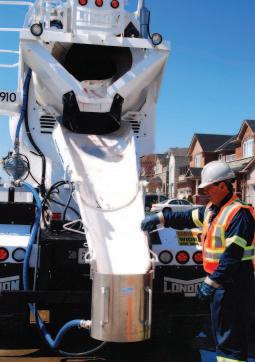

Dufferin’s ‘Enviroguard’ system recycles all ready mix truck chute waste
ORBA Awards First Two Scholarships for Civil Engineering and Technology
ORBA has presented two scholarships this year, with two more to come under the new annual Scholarship Program that was instituted by Paul Quinless, president of the Association in 2010. The awards recognize exceptional students either entering or finishing a course in civil technology or civil engineering.
The first two awards made in June were to high school students entering their first year of a program this September. Blake Purcell of Stouffville will be attending Georgian College this year in civil technology. The winner of the university engineering award is Jordan Kamphuis from Grimsby who is enrolled this year in civil engineering at McMaster University.
The program offers four scholarships each year as follows:
• $3,000 for a student attending an Ontario college or equivalent and entering the final year of their program in a civil technology/technician discipline.
• $3,000 for a student attending an Ontario university and entering the final year of their program in a civil engineering discipline.
• $2,000 to a student attending an Ontario high school and entering the first year of a program in civil technology at an Ontario college or equivalent.
• $2,000 to a student attending an Ontario high school and entering the first year of a program in civil engineering at an Ontario university.
Over 70 applications were received for the high school student awards. Judging of the applications and selection of the recipients is handled by the ORBA Education, Training and Industry Promotion Committee. The deadline for receiving applications from university and college students entering their final year of studies is October 31, with announcements to be made in November. All four award winners will be invited to attend the ORBA convention in February to be recognized by the industry for their achievements.

Blake Purcell graduated from Stouffville District High School this year with excellent marks in the 80s and 90s in his construction and technology related credits. He grew up on his family’s farm where he learned to run tractors and equipment at an early age. At 14, he took a
Blake Purcell
summer job at Fairgreen Sod Farm where he operated the excavator, dozer and rock trucks. At 16, Blake took a job with Todd Brothers Contracting Limited where he learned more about his chosen career including using a laser to grade, installing subdrains, installing pipe, moving earth and understanding plans and specifications.
In his essay required with applications, Blake said he would “like to work somewhere I could one day be a foreman on a job site. I really enjoy large earth moving jobs and running machinery. I know this program (civil technology) will give me many more opportunities where I could become a site supervisor for a consulting company or work for a township.”

Jordan Kamphuis graduated this spring from Grimsby Secondary School with very high marks in all subjects, including 100 per cent in physics and high 90s marks in functions (99), principles of mathematics (98) and introduction to business (97). The head of Grimsby’s mathematics department, Elizabeth Pattison, called Jordan “one of the most academically talented students I have ever had the privilege of teaching in 21 years.”
Russ McBride, Jordan’s high school guidance counsellor, noted that he is not only academically accomplished but Jordon is also very active in his community and sports. He was a member of the senior band and the cross country team. Through his church, Jordan has given countless hours to worthy causes, including mission trips to run camps for impoverished children.
“I want to enter civil engineering specifically because I am a daily witness of the incredible, practical importance of civil infrastructure,” says Jordan of his career goals. “In my engineering career I hope to have an impact on society that is beneficial to as many people as possible.,…Transportation and infrastructure is such a major part of the great foundation of modern society.”

Jordan Kamphuis
Introducing New ORBA Members
Contractor Members
Associated Paving & Materials ltd.

Founded in 1976 by Antonio Copabianco, Associated Paving has remained a family company specializing in paving and related services in and around the Greater Toronto Area. Integral to its operations is Associated Paving & Materials’ asphalt plant located in Burlington, Ontario, which produces all standard mixes, and runs at a mix rate of 300 tonnes per hour. It is also at this facility where the company crushes and stockpiles recycled concrete and asphalt pavement for use and resale.
In addition to its hot mix production, Associated Paving & Materials provides milling, road maintenance and paving, snow removal, excavating and grading, storm and sanitary sewer services, and supplies concrete services including the installation of new curbs, parking lots, roads, retaining walls or other projects.
Associated Paving & Materials services construction and road building clients across the GTA and Southern Ontario. For more information on its paving products and services, visit www.associatedpaving.com, email reception@associatedpaving.com, or call 905-637-1966.
ConCreate USl Inc.

ConCreate USL LP, established in 1971, is a Canadian-owned and operated company specializing in concrete rehabilitation, specialty works and general construction. Its core areas of business include concrete structure rehabilitation for land
and underwater, concrete structures including aqueducts, bridges, reservoirs and tunnels; concrete protection (including waterproofing, traffic topping systems), expansion joints and geotechnical works. In addition, ConCreate USL LP is a major bridge builder and has completed such high-profile projects as the Canada Olympic Park bobsled and luge track and the Shaw Millennium Park in Calgary.
Operating out if its headquarters in Bolton, Ontario, ConCreate USL employs over 400 staff, with offices in cities such as Calgary, Edmonton, Truro and Sarsfield, and branch offices in multiple U.S. locations. ConCreate’s history dates back to 1971, when it first started business as a tunnelling contractor in Moncton, New Brunswick, operating under the name Underground Services Ltd. In 1986, the company expanded its staff and operations to become a full general contractor, and throughout the 1990s it expanded from retrofit projects to the new construction of bridges, post-tension water reservoirs, skateboard parks and other projects for both Canadian and U.S. clients.
ConCreate USL can be found online at www.usl-1983.com. The ORBA representative is Nick Giacalone at ngiacalone@usl-1983.com, or by phone at 800-363-7580.
Associate Members
H.l. Staebler Company

limited “Be Wise – Staeblerize” is the time-honoured slogan of this Kitchener-based insurance company that has provided both personal and commercial clients with an extensive range of insurance products for nearly 140 years. Established in 1873 by J.M. Staebler out
of his home in what was then known as Berlin, Ontario, the company was later passed down to his son, H.L. Staebler, and then sold by the Staebler family in 1963 to Messrs. Selwyn Sangster & Don MacPherson. In 1978, it was bought by the Lorne Philpott & Richard Forler brokerage, where it currently thrives under the leadership of its president Kim Philpott, and its chairman Steven Philpott.
Serving clients throughout North America, H.L. Staebler Insurance protects contractors with insurance products pertaining to bonding, builders’ risk and wrap ups, specific project policies, contractors’ pollution; as well as property, liability, and automobile insurance. The company is also supported by a global network of insurance agencies, providing it the means to back clients with 24-hour support, timely claims responses, and the full breadth of Staebler’s services no matter their location.
H.L. Staebler Company Limited operates out of its offices on 871 Victoria Street, North Kitchener. Further information can be found by contacting ORBA representative Paul Salters via email at psalters@staebler.com, or by phone at 800-321-9187. The company can also be found online at www.staebler.com.
Innovative Surface Solutions

Innovative Surface Solutions has supplied the industry with custom road maintenance solutions since 1986. Located in Ajax, Ontario, the company provides road builders and construction clients alike with proven road safety products designed for de-icing, dust control, and asphalt maintenance under any conditions, and in any season.
Included in Innovative Surface Solutions’ product line are anti-icing, de-icing and pre-wetting products for municipal, commercial, and industrial use. It includes liquid de-icers, formulated to break the bond between ice and snow and the road surface; and granular de-icers, which work by melting the snow.
For summer hazards, Innovative Surface Solutions also supplies effective road stabilization and dust suppressant products such as OPSS approved MgCl2 Flake and CaCl2. Both hygroscopic in nature, these chlorides help to bind fine dust and aggregate particles together to keep surfaces stable and dust free. The company provides pothole patching and tire ballasting products for yearround safety and protection.
More information on Innovative Solutions’ products and services can be found by contacting Angela Steigerwald at asteigerwald @innovativecompany.com or 800-387-5777. The company can also be found online at www.innovativecom-

pany.com and is located at Orchard Road in Ajax, Ontario.
Munro ltd.

Munro Ltd. offers a complete line of the infrastructure products and services necessary to build and rehabilitate large physical networks for fresh water, waste water, transportation and energy. Formerly known as Munro Concrete Products Ltd, the company also supplies the industry with precast concrete, prestressed precast concrete and welded steel products, engineering services and field services.
Munro Ltd’s manufacturing facility is a 44,000 m2 fully integrated, stateof-the-art plant located in Utopia, Ontario. Major product lines are Fresh Water Transmission Pipe and Fittings, Steel Pipe and Fittings, Storm and Sanitary Pipe and Maintenance Holes, Bridge Superstructure and Substructure Components (girders, decks, wing walls), Tunnel Segments,
Railway Ties, Box Culverts and Chambers - the broadest product line portfolio in the industry.
For more information, visit Munro’s website at www.munroltd.com, email info@munroltd.com or careers@ munroltd.com, or call 800-461-5632.
nasiruddin Engineering limited

Operating from its laboratory and head office in Mississauga, Nasiruddin Engineering Limited (NEL) provides consulting engineering, project management, geotechnical investigation, environmental consulting, building science, condition survey, Quality Verification Engineering (construction inspection/certification); as well as construction material testing services including concrete, soil, aggregate and asphalt for public and private sector projects.

Heading the NEL team is Mohammad Nasiruddin, P.Eng., a designated Consulting Engineer and a Specialist in construction materials whose 40 -plus years of experience includes work on over 5,000 projects, including numerous high-profile assignments in Ontario and on ORBA member projects. He is joined by Shakeel Nasiruddin, P.Eng., and Ilyas Siddiqui, P.Eng., who have led teams of inspectors on civil infrastructure projects throughout Ontario, the United States and the Middle East.
Nasiruddin Engineering Limited’s headquarters is located at 6033 Shawson Drive in Mississauga, Ontario, and online at www. nasiruddineng.com. For more information about the company and its services, contact Shakeel Nasiruddin at shakeel@nasiruddineng.com or call the head office at (905) 565-9595.
The Sovereign General Insurance Co.

Incorporated in 1953, The Sovereign General Insurance Co. first appeared on the insurance scene as The Merit Insurance Company. It became Sovereign General in 1974 and expanded on its line of personal insurance products to redirect its focus to commercial products and services. In 1987, The Sovereign General Insurance Company joined The Co-Operators group of companies to become one of Canada’s most prominent insurers.
The Sovereign General Insurance Company operates nine regional and services offices throughout Canada, with its headquarters in Calgary, Alberta. Its independent brokers specialize in providing commercial and
products including Blanket Breakdown, Directors & Officers Liability (D&O), Errors & Omissions Liability (E&O), Commercial plug-ins insurance, Metallic insurance; and other products designed to protect its construction clients against loss due to equipment damage or injury. Additionally, Sovereign provides an equally diverse range of personal insurance solutions.
In Ontario, The Sovereign General Insurance Co. is located in Toronto at 1700-4 King Street West. Other regional offices and broker locations can be found online at www.sovereigngeneral.com, or by contacting Pradeep Girdhar at pradeep.girdhar@sovgen.com, or by phone at 800-365-4430.
· AIR COMPRESSORS · AIR TOOLS & ACCESSORIES · AIREQUIPMENT · COMPACTIONEQUIPMENT · CONCRETEEQUIPMENT · ELECTRICTOOLS & ACCESSORIES · EXCAVATINGEQUIPMENT · FLOOREQUIPMENT · FORKLIFTS · GENERATORS · HEATERS · HIGHREACHEQUIPMENT · LADDERS · LAWN& GARDEN · LIGHTS · MATERIAL HANDLING / LIFTING · PAINTEQUIPMENT · PLUMBINGEQUIPMENT · PUMPS · SAFETYEQUIPMENT · SANDBLAST EQUIPMENT · SCAFFOLD · SHORINGEQUIPMENT · SURVEYEQUIPMENT · SWEEPERS · TRAILERS · TRENCHERS · WASHERS · WELDERS

For a complete listing of equipment and supply requirements, visit our website: www.contractorsrentalsupply.ca

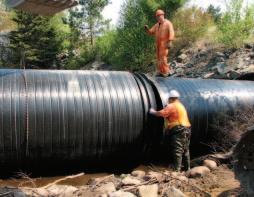
Trenchless Culvert Rehabilitation
• Large diameter HDPE pipes
• Installation guidance available
• Sample specifications for owners & contractors
• Quality verification engineering available
Geogrid Reinforced –Retained Soil System
• TerraSlope®
- Savings up to 70% over concrete retaining walls
- Variable face angles & face options

• TerraSteep®
- Incorporates wire forms to allow for construction of angles greater than 45 degrees, up to vertical
• TerraFort® Panel Wall System
- Uniaxial HDPE Geogrids provide non-corrodible reinforcement
- Full height panels –available up to 10m high
- Precast concrete offers many options for architectural finishes
Biaxial Geogrid for Subgrade Improvement
• Reduce aggregate fill thickness
• Reduce sub-excavation
• Extend service life of pavement
• Reduce labour & equipment requirements
J.C. Rock’s Got Your Stone
By Matt Bradford
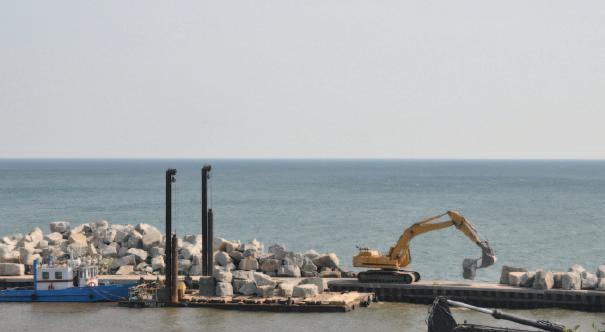
It doesn’t take much digging to get the story on J.C. Rock Ltd. For over 40 years, this ORBA newcomer has been providing natural stone products to road builders, landscapers and construction sites of all shapes and sizes; and its solid commitment to quality, safety and genuine customer service has made J.C. Rock’s name and history well known across Ontario.
Located in Orillia, J.C. Rock was founded in 1970 by Jim Wiles, who entered the industry as a supplier of trucks and trailers for transporting armour stone. Years later, Wiles’ work with Dufferin Aggregates put him in touch with Terry Waites who, along with his partner Cynthia Lis, purchased the company from the Wiles family in 2008, and has since grown J.C. Rock’s reputation and reach within the construction and landscaping industry.
“[Jim] would go in and sort, handle, and manage rock out of other people’s
quarries that other suppliers didn’t want to deal with. He would go in as a subcontractor and supplier to do that type of work and that’s how I met him; he was a Dufferin customer,” says Waites, recalling J.C.Rock’s change in ownership, adding, “At the time, I was sales and marketing manager for Dufferin Aggregates, and I had an opportunity to buy this business, so I did.”
J.C. Rock Ltd. has two quarries, a head office in Orillia, a fleet of trucks, and a staff of 15 to 20 equipment operators, drivers, and office and sales personnel depending on the volume of business. While the company has shipped as far east as Ottawa, and as far west as Leamington, J.C. Rock’s main market resides in Southern Ontario where it provides road builders, construction contractors and landscaping suppliers alike with a wide array of armour and landscaping stone. For its road builder and construction customers, J.C. Rock’s provides 14”
to 32” armour stone for retaining walls, shoreline protection and decorative landscaping; and step stone and similar material for landscaping projects. The company also provides rip/rap and gabion used in shoreline protection and erosion control.
“We play in two industry segments,” explains Waites. “For one, we do erosion control, which is, we supply revetment armour stone, rip/rap and gabion for rivers, lakes and streams. We also do business in the landscape segment, for both commercial and residential use. Our quarries supply small and large stackable armour, waterfall rock, weathered cap rock, step material, curb stone, 14” cubes and a variety of other landscape products.
Of all its products, J.C. Rock’s chief export is armour stone, which it supplies in equal quantities to both its construction and landscaping clients. “We’re evenly focused on both,” says Waites.
J.C. Rock is supplying 12,000 tonnes of armour stone for the rehabilitation of the East Pier at Oakville Harbour
“The landscape side is quite a bit different. We supply garden centres and depots and landscape contractors, and it’s a totally different product – it’s a higher end product. Quite often, it’s more of an aesthetic sale. We’re focused on both and it keeps us active and keeps us busy.”
Stone for J.C. Rock’s projects is culled from the company’s own quarries located in Crookston and Norland (east of Orillia) and local quarries. Adds Waites: “[landscape stone] comes out of our own quarries, but when we do the erosion control work, which is with large armour stone, then we generally go in and sort and take that out of other people’s quarries, and then take that to market.”
J.C. Rock separates itself from the competition in a number of ways. Primarily, Waites says the company takes a special interest in safety, as demonstrated in its adherence to BROWZ safety and performance certification standards.
“Safety and service are a big factor for us. We have the ability with our own equipment and our own trucks to do that,” he notes.
In addition to its focus on safety, J.C. Rock’s niche is its willingness and ability to go above and beyond for any project, no matter the requirements. According to Waites: “We have the ability to go in and do specialized work. We actually go into quarries and do things other people don’t do. We’ll go in and take the rock out of the muck, sort it, have it approved for the job, and put in on our truck and deliver it to the project. There really isn’t anybody else doing what we do.”
A prime example of this is its recent work in Stoney Creek on Green Millen Drive, a project Waites regards as one of the largest and most demanding in J.C. Rock’s history. The task brought a bulk of J.C. Rock’s crew to the edge of Lake Ontario for a shoreline protection job that required 30,000 tonnes of four- to six- tonne armour and eight- to 10-tonne armour. J.C. Rock pulled the rock from three separate quarries, and added 12,000 tonnes of 12” x 24” rip/rap along the shoreline. Looking back at the four-

INCREASE ROI ON YOUR CONSTRUCTION EQUIPMENT

AUTOMATIC LUBE SYSTEMS














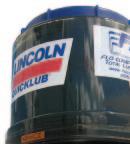






J.C. Rock’s quarry in Norland
GO WITH THE FLO!
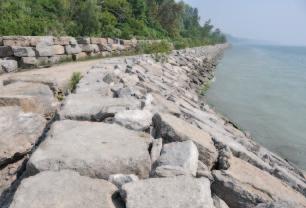

month project, Waites recalls: “That kept us hopping all winter.”
Looking forward, Waites hopes to keep his crew challenged with more projects of that nature, as well as continue to grow the company, its resources, product line and customer base.“We’re always looking for new opportunities to expand quarries that we either have access to or we own.”
For the time being, however, J.C. Rock’s management is excited to explore the benefits of their new membership with ORBA. And they’re already off to a great start.
“A lot of my old friends that are contractors that I dealt with for years and years are members of ORBA,” says Waites, adding, “They have, from time to time, required
us for erosion control for a small part of their road building projects, or they have large armour stone retaining walls which we also supply. So we’re pricing work and doing work for ORBA members quite often.”
J.C. Rock can be found online at www.jcrock.ca


J.C. Rock at work on the Meadowcliffe Drive Shoreline Regeneration Project on Lake Ontario for the Toronto and Region Conservation Authority
30,000 tonnes of armour stone and 12,000 tonnes of rip/rap was required for J.C. Rock’s project in Stoney Creek on Green Millen Drive
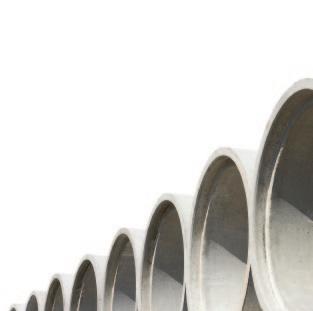

Standards Compliant
Meets specifications set by CSA, OPSS, ASTM Leak free
Unique integral seamless bell construction
Environmental stability
Resists acids, bases and salts; unaffected by bacteria, fungi and aggressive soils
Excellent flow characteristics
Carry high flows in smaller pipes
Lightweight & flexible
No heavy lifting equipment needed; excellent in unstable soils; resists the effects of freezing
Ductility and toughness
Resists damage caused by external loads, vibrations and internal abrasion

CFAAST Report says There’s Room for Improvement at MTO
The Deputy Minister of Transportation, Carol Layton, has released an independent review of the Ministry’s claims and infractions processes that recommends ways to improve the relative “fairness, equity and transparency” of some of those processes. The review was initiated by the Deputy Minister in response to concerns raised by ORBA and individual ORBA members and it was completed by the Corporate Financial Assurance Audit Service Team (CFAAST), Internal Audit Division of the Ministry of Finance.
“CFAAST observed a number of opportunities for the Ministry to consider which could enhance the fairness, equity and transparency of the overall process,” stated the report in its executive summary. It was also quick to clearly add that enhancing process fairness has an associated cost and “management is fully responsible for weighing the cost and benefit of implementing each recommendation.”
The report was released at the same time as ORBA had just wound up related discussions with MTO staff on issues raised by members about how the Ministry was administering liquidated damages in the field. Now, with the broader review public, ORBA has asked the Minister of Transportation for joint discussions on the broader CFAAST recommendations that would also include remaining issues on the liquidated damages subjects.
“With the release of the CFAAST report and recommendations we see a significant opportunity to discuss real changes with MTO on some fundamental issues about fairness and balance
of risk we have been raising with them for many years,” said ORBA executive director, Rob Bradford. “We hope the Minister will agree to hold those joint discussions with us.” (See sidebar for ‘Key CFAAST Recommendations’.)
The Ministry has already provided general responses to each of the recommendations in the CFAAST report. In most cases the responses commit to further review of the recommendation within specified timelines, but in some cases MTO has already reported changes that it will introduce to its processes.
How we got from there to here takes a bit of unravelling. In November 2010 ORBA took some concerns from members to MTO about how liquidated damages were being administered in the field. There were issues of LD’s being taken before completion, at interim completion dates and, most importantly, before contractors believed the underlying reasons for delays had been resolved. The Ministry investigated and found many of the concerns raised by ORBA were in fact manifesting themselves on projects. Indeed, the province’s public accounts later showed that the amount taken in liquated damages from contractors in 2010-11 increased by a measure of six fold from the year before.
The Ministry responded proactively with a commitment to look at the liquidated damages process and make changes where necessary. ORBA met with the Ministry through late 2010 and the early months of 2011 through a new joint Contracts and Documents Committee, chaired at ORBA by Scott Taylor, McLean Taylor Construction.
While work continued on the joint liquidated damages discussion, several contractors approached the Minister of Transportation to bring to light their broader concerns about the Ministry’s whole claims and infractions processes – and you can’t talk about them without necessarily also looking at MTO’s prequalification and disputes resolution processes. The contractors had issues concerning their own companies, but many of the points they raised about process and fairness had industry-wide implications and had been brought to the Ministry by ORBA repeatedly in the past.
Deputy Calls for Review
Arising from those representations to the Ministry of Transportations and ORBA representations, last January the Deputy Minister requested the CFAAST review of the “fairness, equity and transparency” of MTO’s claims and infractions processes. In April, ORBA submitted a comprehensive industry opinion and recommendations to the audit team. The review also included interviews with some ORBA members and other contractors, as well as Ministry staff.
ORBA concluded its discussions with MTO in June with the acceptance of a “15-Point Plan” (the ‘Plan’) to address the administration of liquidated damages. It was missing a key principle originally proposed by ORBA: that liquidated damages should not be assessed until after claims for the causal delay are resolved through, if necessary, an independent, third-party process. The ORBA Board of Directors struggled with the decision to accept the Plan without the third-party decision principle, but eventually found
enough merit in the 15-point proposal to vote unanimous acceptance.
For ORBA the centrepiece to the Plan was the Ministry’s agreement to the contractor’s option of taking a delay claim to a third-party, binding arbitration after it had made its way through the Ministry’s own three-step resolution process. Some of the 15 points were simply agreement to ensure that things were done the way they should have been in the first place – for instance, the Ministry’s agreement that liquidated damages cannot be taken until after a project is completed and until a causal delay claim has been through the three-step process and is still unresolved. Others of the 15 points were more general objectives with agreement to talk more, but if those objectives are realized they should help to reduce delay claims at the front end, and provide a binding, third-party decision to resolve them at the other.
Broader Consultation
Fast forward now to mid-September and two key events that changed the status of the 15-Point Plan. First the release of the CFAAST report to ORBA that dealt with issues that had been under discussion specifically related to liquidated damages, and clearly indicated that a broader discussion is necessary.
Secondly, immediately prior to the CFAAST report release, MTO advised ORBA that the new binding arbitration process would be subject to application of the ‘Exclusion Clause’. The exclusion clause is a provision found in MTO’s prequalification documents that says essentially that the Ministry can reduce or terminate a contractor’s bidding privileges for exercising its right to take the Ministry to court in a frivolous or otherwise unacceptable manner. ORBA opposed the clause when it was introduced almost a decade ago and continues to oppose it today as an intimidating provision that seeks to restrict access contractors’ legal rights.
For those two reasons, on September 12 ORBA advised the Deputy Minister that it wished to withdraw its support for the 15-Point Plan and requested instead
joint discussions on the CFAAST recommendations, including all outstanding issues from the Plan. Although it could not accept a binding arbitration process that would expand the use of the exclusion clause, the ORBA Board of Directors sees the confluence of events as a positive opportunity to take a ‘bigger picture’ look at the intertwined issues related to fairness and equity of MTO processes for managing contractors.
In a late September letter to Transporta-
tion Minister, Kathleen Wynne, ORBA emphasized its optimism that: “… the release of the CFAAST report provides an ideal opportunity to continue our joint discussions on issues related to the 15-Point Plan in a broader consultation that includes all of the recommendations in the CFAAST report. The report establishes the opportunity for significant and meaningful improvement to the claims and infractions processes through joint consideration of the recommendations.






Precast Concrete Piles, Seamless, ERW & Spiral Weld Pipe Sheet Pile, Bearing Pile, WF Beams
Steel Foundation Products
Key CFAAST Recommendations
Following is a summary of some of the main recommendations of the CFAAST report. The points have been edited for brevity and not all recommendations are included. The complete CFAAST report is available on the ORBA website at www.orba.org
In each case, recommendations from the CFAAST report are prefaced with the qualifier that the Ministry of Transportation should “consider” recommended actions.
• A review of the policy of applying liquidated damages and/or sanctions for infractions while related claims are in dispute to identify opportunities to enhance the perception of process fairness.
• A review of the alignment of various consequences to consider the potential cumulative impact to contractors.
• An internal process review to improve efficiency and timeliness in reviewing claims
• Re-evaluate the need for the litigation component of the exclusion provision in the Ministry’s qualification procedures.
• Exploring options to enable ADR earlier in the dispute process, involve experienced and relevant parties earlier in the claims process and use adjudication as a method of dispute resolution.
• An internal review to find reasons for claims resolution timelines between regions and the discrepancies between regional and head office decisions.
• A review of the claim denial and infraction decision communication processes to identify ways to improve process consistency and transparency.
• Detailed clarification to contract administrators on the required content and level of detail for CA claim recommendations.
• Requiring contractors to provide formal feedback on CA performance and consider that feedback in completing formal CA performance evaluations.
• An independent cost/benefit analysis to determine if letters of credit and bonding should be required on MTO projects.
• A central process to track claims and contact with contractors to enable accurate and timely responses to contractor questions and status requests.
• More detailed decision-making criteria for adjudicating sanctions for infractions and communicating the criteria to contractors.
• The Qualifications Committee should adopt formal attendance rules and operate with a minimum quorum of 50 per cent.
• Implement a “Fairness Monitor” concept to enhance contractors’ perception of process fairness.
Crash Cushion Solutions






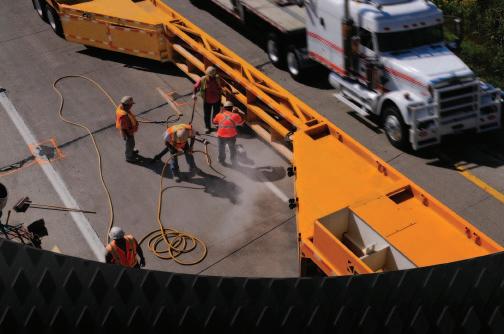






ORBA Honoured on 30th Anniversary of Muskoka Steamship’s Rebirth
By Rob Bradford
Between 1973 and 1981 ORBA was instrumental in saving one of Ontario’s most important historical artifacts, The Royal Mail Steamship Segwun. It is the only vessel of her type still afloat and operating under steam anywhere in North America, and perhaps the world. And on June 3 ORBA was honoured in Gravenhurst by the Muskoka Steamship & Historical Society at a luncheon and tour of the Muskoka lakes to mark the 30th anniversary of the Segwun’s re-entry into service.
“By acting as corporate sponsors of the restoration and seeing it through to a successful completion your organization saved a priceless piece of Canada from oblivion and made it possible for present-day patrons to experience once again the delights of steamship travel on the beautiful Muskoka lakes in old-time style, said Richard Tatley, historian and past director of the Steamship Society.
ORBA past president Tom O’Callaghan and executive director Rob Bradford were presented with a framed,
numbered print of the Segwun from a painting by a local artist.
At the June ceremonies Tatley told the crowd that ORBA had jumped in to raise the money to save the Segwun because road builders felt guilty about bringing an end to the steamships as the predominant method of travel in Muskoka. While that is likely more legend than truth, during an afternoon cruise on the lakes Tatley was a wealth of information about times when Gravenhurst was the transportation hub of the North and how beginning in the mid 1860s all goods and people moved past there by steamship. He talked about the city people who used to boat in to the famous old resorts dotting the lakes for summer vacations – places like Windermere House and Clevelands House – and about how the coming of roads quickly relegated the old steamers to a tourist attraction.
The Muskoka historian has written several books about the old steamships that used to rule the lakes and he
describes how ORBA saved the Segwun in a special essay on the subject. The following description is derived from Tatley’s essay.
The Segwun was built in 1887 as a sidewheeler and was first called the Nipissing. It was re-renamed in 1925 when the twin-engine, coal-burning steamship was converted to twin screws. In three careers, the Segwun has logged over 90 seasons of active service. The Segwun was taken out of service in 1958, tired and no longer economically viable. In 1962 she was almost sold for scrap but the Town of Gravenhurst agreed to salvage her as a floating memorial to the age of steam. Apparently doomed to just rust away into irrelevance, in 1969 a young marine engineer from Toronto with a vision began the drive to save the Segwun.
Drive to Save Segwun
John. W.B. Coulter had worked on the Segwun in his student days and he kick-started a restoration committee involving local residents and Tatley. “A little money was raised, a few repairs were made, publications produced and efforts made to garner support,” he says. But then pinhole leaks were found in the ancient iron hull and it became clear that only a major rebuild would save her.
The project looked dead in the water until the “major breakthrough came ... Some executives of the Ontario Road Builders’ Association learned of the Segwun’s plight

and conceived the idea of acting as patron sponsors of a restoration.” In March 1973 ORBA president Bill Cole and his executive invited the local restoration committee to a meeting in Gravenhurst and a deal was struck. ORBA would purchase the ship from the Town and restore it to operating condition, then hand it back to local control when it was completed. Bill Cole became the first president of the Muskoka Steamship & Historical Society and ORBA loaned the Society $24,000 to get started.
By mid-summer ORBA had rebuilt the old marine railway at the Gravenhurst waterfront and the Segwun was pulled from the water for the first time in 18 years. For the next 10 months Gravenhurst relived its shipbuilding glory. All of the shell plating on the hull below the waterline was removed and replaced section by section by the ship building firm of Herb Fraser and Associates of Port Colborne. Collingwood Shipyards fabricated the new plates. The rudder and propeller shafts were replaced.
After spending $250,000 to rebuild the hull, it seemed nothing could go wrong that bright, windy June morning in 1974 when Prime Minister Pierre Trudeau broke the ceremonial bottle of champagne across her bow and the Segwun slid back into the water. There was more work to do, but the hard part was supposed to be over and no one could have fathomed just how much more.
CONTRACTORS FOR MUNICIPAL & MTO PROJECTS
CENTRELINE & TRANSVERSE MARKINGS
Water Based Materials & Alkyd Based Materials
THERMO PLASTIC & METHYL METHACRYLATE
Spray, Inlaid & Overlay Methods
LINE REMOVA L
Rotary Grinding, Abrasive Blasting, Water Blasting VariousBlackout/Tape Methods 45
Serving Ontario Municipalities and the MTO for over 33 years.



As Tatley describes the situation once they started taking a closer look at the Segwun: “The Ministry of Transport (federal) kept thinking up new ways to increase the costs. They demanded fire-proof partitions inside the vessel, fireretardant paint throughout, shatter-proof glass in almost all the windows, a complete new double-wiring system, a complete set of steel bulkheads throughout the hull (requiring significant re-design) and much more.
“The road builders wearily renewed their efforts,” says Tatley. “Glen Coates of Fowler Construction became the ORBA president and replaced William Cole on the project. Despite the problems, the ship’s exterior decks were rebuilt in 1974. The boiler was sounded out and retubed, the steam lines gradually replaced and the engines tackled in 1977.”
Still more money was needed though and ORBA had reached its limit in being able to raise more funds from its members after the project had already ballooned far beyond original cost predictions. The Segwun would need more work on the engines and steam radiators in the lounges. Railings had to be replaced and the interior lounges and passenger spaces had to be outfitted and decorated. The straw that almost broke the camel’s back was when it was discovered that the piston rings in the engine’s cylinders had to be replaced. Work went slowly and as money became available. The Ontario government came through with $250,000 in 1976 and another $60,000 was raised through a lottery. By the time the Segwun finally began carrying passengers again in June 1981, the restoration had cost $1.1 million.
For the next three seasons the Segwun would lose money and some began to doubt whether it could survive as a viable tourist business. But as marketing improved and crews relearned the art of operating such a vessel, in 1985 the venture finally turned a profit and it has never looked back
WORK ZONE SUPPLIES








CIC Talks About Decommissioning Fees, Sustainable Infrastructure and Environmental Assessment at Quebec City Meetings
New decommissioning fees for nuclear gauges, hours of service regulation, environmental assessment and sustainable infrastructure construction highlighted the agenda September 24 at the meeting of the Civil Infrastructure Council of the Canadian Construction Association held in Quebec City.
The newest agenda item, nuclear decommissioning fees, was of particular importance to ORBA, executive director Rob Bradford told the national council. ORBA contractor members have enough labs and operate enough nuclear gauges to make the new fees extremely onerous as proposed. He noted that ORBA also represents Associate members who operate private testing labs and the impact of the new fees might even be greater on their businesses.
The issue arises from the Canadian Nuclear Safety Commission’s (CNSC) current industry consultation on a change in policy that will affect road builder and heavy construction members that use portable nuclear density gauges. The proposed new policy will require users of these gauges to provide a financial guarantee to cover the decommissioning costs related to the termination of a licensee’s licence. The potential fees or guarantees for any given contractor or private lab could well be into the tens and even hundreds of thousands of dollars.
When CIC first received news of the new decommissioning fees the greatest
concern was that cash payment would severely impact contractor costs and perhaps even the viability of smaller testing labs. However, discussions with the CNSC have established that the civil construction industry will be able to comply with the required guarantees with surety and insurance instruments. As well, a ‘threshold of liability’ will be established to determine applicability of the policy.
The CIC is now working with the insurance and surety industries to develop a guarantee instrument that will satisfy CNSC requirements. At the September meeting of the Civil Infrastructure Council, David Dykes, president and CEO of the Western Surety Company, assured Council that a suitable surety instrument can be developed.
For most contractors, liability will be based on the number of gauges alone. A charge of $3,000 will be applied for each gauge. In addition, the Commission will also apply a one-time $10,000 administration fee. Companies with a liability of less than $75,000 will be allowed to provide a declaration to the Commission attesting that they have made provisions within their financial operations to set aside funds sufficient to cover the decommissioning of their existing nuclear equipment.
Those companies with a liability greater than $75,000 will be required to either deposit in trust funds sufficient to cover their liability or provide the Commission with proof that they have coverage
(insurance, surety bond, cash or cash equivalent, or letter of credit) sufficient to cover their liability. In short, ORBA members with no uncontained nuclear material in storage but more than 21 gauges will be required to pay a financial guarantee, whereas those with fewer than 21 gauges will not.
The CIC is now preparing a more detailed response to the Commission to document the industry’s concerns and presenting recommendations for an insurance or surety-bond based solution.
Environmental Assessment
The precedent-setting ‘Red Chris’ legal decision has created considerable delay in Ontario on projects such as the fourlaning Highway 69 north to Sudbury and discussion at the CIC indicated there are similar concerns across the country. The decision established that federal environmental assessment must consider entire projects, changing the prevailing practice of achieving environmental approvals for major portions of the project.
Bill Ferreira, executive director of the national CCA infrastructure council, told provincial members that the federal government is undertaking a review of Canadian Environmental Assessment Act (CEAA) in October. CCA will present a formal submission on the subject and ORBA has asked that the national statement also speak strongly to the need to better coordinate the federal and provincial environmental assessment processes – preferably by arriving at a single,
practical process meeting the needs of both jurisdictions.
Rating Sustainability
The CIC meeting also heard a presentation from Bill Bertera, executive director of the Washington-based Institute for Sustainable Infrastructure. The Institute is a creation of the American Public Works Association, the American Council of Engineering Companies and the American Society of Civil Engineers. Its mission is to develop and promote a sustainability rating tool for infrastructure project. The trademarked name of the tool is ‘envision’ and it seeks to bring a sustainability discipline to infrastructure projects in the same way that LEEDS is becoming mainstream in the vertical construction industry.
There are other rating systems out there, said Bertera, over 900 of them, but the envision rating system is the only one that takes a holistic approach and addresses social and economic issues. The envision rating system looks at an infrastructure project based on 10 key areas such as land use and restoration, project pathway, ecology and biodiversity and water resources. As many as 74 different variables are used in the rating process and projects are rated on how well they achieve community and public goals in a manner that reflects future resources and needs.
The CIC will now look into the potential benefits of membership in the Institute for Sustainable Infrastructure. While the rating tool is built for the American market, it can be easily Canadianized by a group such as CIC.
Hours of Service
While it is beginning to take on the feeling of a never-ending saga, CIC continues to work with Transport Canada and the Council of Canadian Transportation Authorities to gain relief for civil construction contracts under the federal hours of service regulations for commercial vehicle operators. CIC is looking for changes to the regulations that would allow drivers in construction some leeway in terms of hours worked in a day (or a week). The argument being put forward
is that these are short-haul drivers who are not constantly in their vehicles while on duty.
If the federal authorities do agree to some changes for civil construction, it will impact only companies that are registered as federal carriers. In the provinces, it would be up to provincial governments to adopt any changes set out in the federal guidelines. A presentation was made
by CIC earlier this year and a response is awaited.
On another issue related to vehicles, CIC members heard at their meeting that the federal government is bringing in new emissions standards for 2014, based on the new Tier II engine technology. The federal government has confirmed, however, that there will no retroactivity applied to the enhanced standards.
If you or someone you know are mentally or physically disabled, you could be eligible to receive $15,000 or more back from your taxes
DO YOU OR A FAMILY MEMBER HAVE ANY OF THE FOLLOWING CONDITIONS:
OSTEOARTHRITIS
RESPIRATORY DISORDER • RHEUMATOID ARTHRITIS • SCHIZOPHRENIA • SEIZURES • STROKE • TOURETTES • TUMORS

WHAT ARE DISABILITY TAX CREDITS?
A Federal Income Tax Credit can be claimed by individuals meeting certain medical conditions based on CRA (Canada Revenue Agency) criteria. Those qualifying for the DTC (Disability Tax Credit) may receive up to $1,500 per year or more for each year of their disability going back up to 10 years. Anyone suffering from a physical/mental disability for a period of one or more years that affect basic life activities may apply. Your medical practitioner must complete an application confirming the individuals disability/condition.

BENEFITS INCLUDE: A retroactive claim for every year that you have suffered from this condition. This could be worth $15,000 or more to qualified individuals. An annual future credit of $1,500 or more per year, Registered Disability Savings Plan Qualification status.

Road Building Academy Prepares for Sixth Year


WFebruary 27 to March 2 and the following week of March 5 to 9. Courses are delivered in Mississauga and run from one to four days in length.
The ‘A Day in the Life: Practical Skills for Onsite Foremen’ course has a new name and has been expanded to three days to inject some of the ‘people’ skills into what was already an extremely well received practical course for crew leaders, foremen and new hires. The course covers topics such as environmental management, scheduling, site documentation, quality control, change orders, claims management and other topics that impact the day-to-day work of site employees.
New for this year is our Leadership Skills for Construction Managers and Supervisors. This program is delivered by PROOF Management Consultants and it takes the best from two previous programs and combines them into two days of content rich education. The course covers everything from transitioning into management and motivating employees to conflict management, goal setting, coaching and mentoring and problem solving.
The ORBA Education Committee has also revamped the ‘Environmental Compliance for Civil Contractor’ course so it will be delivered now in two days instead of three. It is an absolute necessity for site supervisors responsible for environmental management.
For 2012 the Education Committee has also taken a number of full-day programs delivered in the past by Excel Through Learning and picked
elcome to the sixth annual Road Building Academy – two weeks of Gold Seal accredited management
education courses for the civil construction industry.
The Academy runs in 2012 from
The ORBA Education Committee met recently at Georgian College to plan the 2012 Road Building Academy program




the most important lessons from each of them. The result is a two-day program teaching valuable personal skills from time management and conflict resolution, to coaching/ mentoring, delegating and effective communications. Register for the course called Building Personal Skills for Peak Performance.
Other courses to be offered at the
2012 Road Building Academy include:
• Construction Contract Law (2 days)
• The Changing Workforce: Diversity and Generational Differences (one day)
• Effective Negotiating Skills (1 day)
• Occupational Health and Safety Due Diligence (1 day)

• Hot Mix Asphalt Technology (3 days)
• Concrete Technology (4 days)
Watch the ORBA website at www.orba.org in November for full details on the 2012 course offerings and registration information or call the Association to inquire at 905-507-1107.

Bart KantersConcrete Technology
Monroe PorterLeadership Skills
Barry Thompson - Onsite Foremen A Day in the Life
15e_Vince Aurilio p Hot Mix Technoloogy
ORBA Member News
EllisDon
Buys looby
EllisDon Corporation announced in August the acquisition of Looby Construction of Dublin, Ontario, specialists in bridge, culvert and dam construction and repair since 1904. EllisDon says the acquisition supports its “corporate goal of continuing to expand their presence in civil work and new markets in Ontario. The entire Looby staff of over 100 employees will be staying with the company which will operate as a stand-alone entity within EllisDon’s civil division. Stan Connelly and Joe Looby will continue in their leadership roles with Looby Construction.
EllisDon president and CEO, Geoff Smith, said the Looby acquisition was “particularly attractive to us because it shares the same values, vision and relationship philosophy that drives Ellis-Don. Looby has built its business on sound and stable financial performance.”
Atlantic Industries
Acquires HlH Walls
Atlantic Industries Limited has purchased the business assets of Harder Luckey & Hargrave Inc. (HLH Walls), an industry leader in sound mitigation wall systems. HLH Walls manufactures lightweight
‘Tuf-Barrier’ and ‘Silent Protector’ noise wall systems and offers turn-key solutions including design, product development, engineering, testing, manufacturing and project management. The company is headquartered in Fergus, Ontario, and has a North American distribution network.
“HLH’s products and expertise are perfect complements to our engineered infrastructure solutions in retaining walls, structural plate, modular bridges and drainage pipe,” said Kenzie MacPherson, president of Atlantic Industries.
Miller one of Canada’s 50 Best
The Miller Group was named one of Canada’s 50 Best Managed Companies this year. Criteria to qualify for the award include growth opportunities via mergers and acquisitions, innovation, business development in the U.S., customer relationships, succession planning and adoption of green strategies.
“We now proudly display the Canada’s 50 Best Managed Companies logo on our letterhead along with our recent 2011 Greater Toronto’s Top Employer Award,” said the company.
Golder Merges
with HB lanarc
Golder Associates, a leader in consulting, design and construction services in earth, environment and the related areas of energy, has merged with HB Lanarc Consultants, a full-service ‘green solutions’ consultancy that specializes in planning and design for sustainability.
For Golder, the merger boosts its market position in the real estate, transportation, waste and power sectors by enhancing planning capabilities in urban communities, sustainable development, energy management and consultation/ facilitation. HB Lanarc gains more reach and opportunity in Canada and around the world for their innovative ideas and more resources to build their team and tools.
Beck Receives Engineering Honour
John Beck, chair and CEO of Aecon Group was inducted into the Canadian Academy of Engineering in June. The academy is a national institution through which Canada’s most distinguished and experienced engineers provide strategic advice on matters of critical importance to the country.

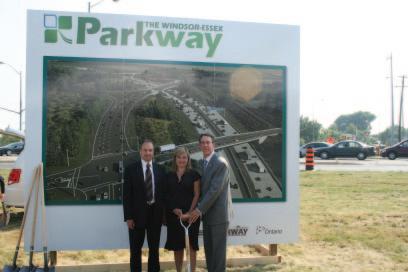
ORBA Director of Government Relations, Karen Renkema (Centre), attended the groundbreaking this summer for the huge Windsor Parkway project. Left is Steve Cripps, MTO Chief Engineer, and Fausto Natarelli, director of the Windsor Border Initiative Implementation Group.










www.aecon.com
Inc.
BPT Components & Parts 57 www.bpt.on.ca
Bruell Contracting Ltd. 56
Canadian Asphalt Industries Inc. 53 www.canadianasphalt.com
Canadian Scale Company Ltd. ............ 22 www.canscale.com
Capitol Event Theatre 60 www.capitolevents.ca
Carillion Canada Inc. Inside Front
www.carillion.ca Cedar Signs Inc.
www.cedarsignsinc.com
Chateau Le Jardin
Conference & Event Venue 60 www.lejardin.com
Con Cast 45 www.concast.com
CRS Contractors Rental Supplies ......... 40 www.contractorsrentalsupply.ca
Creighton Rock Drill Ltd. 24 www.creightonrock.com
Davroc & Associates Ltd. 62 www.davroc.com
DNX Castonguay Inc. 24 www.castonguay.ca
Flo Components Ltd. 43 www.flocomponents.com
Construction Ltd. Outside
www.fowler.ca
GeoShack 25 www.geoshack.ca
Glasvan Great Dane ................................ 35 www.glasvangreatdane.com
165 Cartwright Avenue, Toronto, Ontario M6A 1V5 Tel: (416) 785-5110 Fax: (416) 785-5120 www.petomaccallum.com ASPHALTIC CONCRETE MIX DESIGN AGGREGATE SELECTION AND EVALUATION
QUALITY CONTROL INSPECTION & TESTING
CCIL/CSA CERTIFIED LABORATORIES PAVEMENT EVALUATION & DESIGN Gary Haskett – Mobile: 519-274-2851 Jason Haskett – Mobile: 519-274-2850
BARRIE, HAMILTON, KITCHENER, TORONTO


Quality Field & Laboratory Testing Equipment
Dundas Street E. (Hwy. #5), Dundas, ON L9H 7H8
(905) 689-7327 • Toll Free: 1 (800) 263-9244
info@mltest.com • Fax: (905) 689-3978 • Website: www.mltest.com
P:800-206-6600 F:416-487-5893
McAsphalt Industries Limited 15 www.mcasphalt.com
McCormick Rankin Corp. 62 www.mrc.ca
McNichol Trucking Ltd. 61
Mechanical Advertising 53 www.mechanicaladvertising.ca
Metro Pavement Markings Ltd. 47 www.metropavementmarkings.ca
NILEX Civil Environmental Group 37 www.nilex.com
Nortrax 6 www.nortrax.com
On Track Safety Ltd. ................................. 11 www.ontracksafety.ca
Peninsula Construction Inc. 57 www.peninsula.ca
Petrela, Winter & Associates 17 www.petrela.com
MacCallum Ltd. 61 www.petomaccallum.com
Pipe & Piling Supplies (Central) Ltd. 47 www.pipe-piling.com
Powell Mobile Barriers 49 www.powellmobilebarriers.com
QMB Barrier Systems ............................... 48 www.qmb.ca
Reinforced Earth Company 26 www.recocanada.com
Ritchie Bros. Auctioneers Canada 13 www.rbauction.com/getitright
Roadtec 5 www.roadtec.com
Rodway Marketing 49 www.rodway.ca
Schooner Transport .................................. 62 www.schoonertransport.com
St. Mary’s Cement 51 www.stmaryscement.com
Stacey Electric Company Ltd. 44 www.staceyelectric.com
Stinson Equipment Ltd. 26 www.stinson.ca
Rocco Liscio, M.Eng., P.Eng. Vice-President
2051 Williams Parkway Unit 21
Brampton, Ontario L6S 5T4
Tel:(905) 792-7792
Fax: (905) 792-7829
Cell: (416) 560-7700
Email: rocco@davroc.com www.davroc.com

BIG JOB OR SMALL TOROMONT PAVES THE WAY
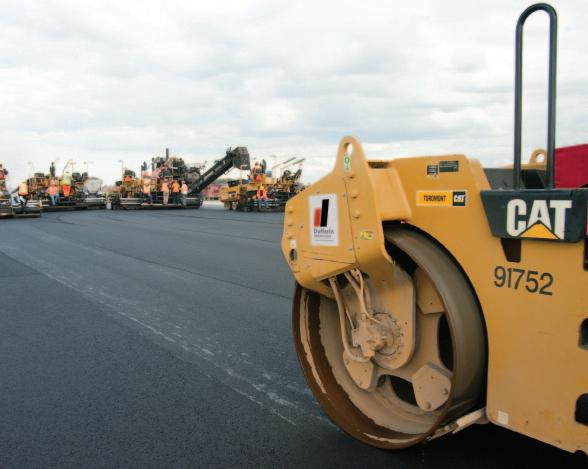
Whether it’s helping you choose the equipment you need or working to enhance productivity on your paving project, finding ways to cut your costs or providing the tools to monitor your equipment efficiency, the Toromont Cat Paving Products team is there for you, 24/7. Drawing on a wide range of experience, solutions, services, products, including operator training, Toromont can help you lower costs, enhance productivity and manage your business for maximum success, maximum profit.

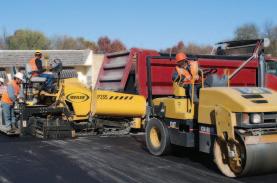



HL-1 STONE, D.F.C., S.M.A.
HL-1 STONE, D.F.C., S.M.A.
HL-1 STONE, D.F.C., S.M.A.
ASPHALT AGGREGATE SUPPLY
ASPHALT AGGREGATE SUPPLY
ASPHALT AGGREGATE SUPPLY
HL-3 MODIFIED, SP12.5FC1 & 2
HL-3 MODIFIED, SP12.5FC1 & 2
HL-3 MODIFIED, SP12.5FC1 & 2
2 QUARRIES TO SERVE YOU
2 QUARRIES TO SERVE YOU
2 QUARRIES TO SERVE YOU
HL-3 MODIFIED, SP12.5FC1 & 2
2 QUARRIES TO SERVE YOU
BRACEBRIDGE AND PARRY SOUND
BRACEBRIDGE AND PARRY SOUND
BRACEBRIDGE AND PARRY SOUND
2 QUARRIES TO SERVE YOU
BRACEBRIDGE AND PARRY SOUND
BRACEBRIDGE AND PARRY SOUND
Barrie Gravenhurst
